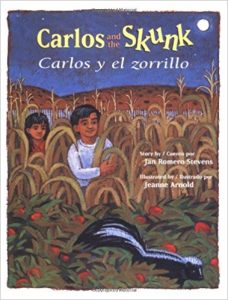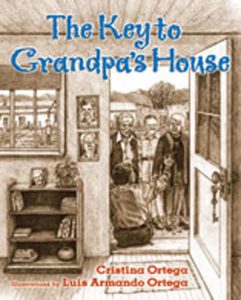 Under a smooth gray rock on the outside windowsill of a home in Chimayo, New Mexico, sits la llave–the key–to the home of Grandpa and Grandma Ortega. The key has always been there for family, friends, and neighbors to use. When Grandma Ortega passes away, some things change and some things stay the same. Grandpa now lives alone, but his life is still filled with loving family and friends and la llave is still resting underneath its rock. Cristina Ortega’s latest children’s story represents life on a northern New Mexico plaza while highlighting the respect, friendship, trust, commitment, and love found in the community. Spanish phrases within the text and detailed illustrations by Cristina’s brother, Luis Armando Ortega, combine to demonstrate to children the importance of these timeless values.Reading level: grade 4 and up
Under a smooth gray rock on the outside windowsill of a home in Chimayo, New Mexico, sits la llave–the key–to the home of Grandpa and Grandma Ortega. The key has always been there for family, friends, and neighbors to use. When Grandma Ortega passes away, some things change and some things stay the same. Grandpa now lives alone, but his life is still filled with loving family and friends and la llave is still resting underneath its rock. Cristina Ortega’s latest children’s story represents life on a northern New Mexico plaza while highlighting the respect, friendship, trust, commitment, and love found in the community. Spanish phrases within the text and detailed illustrations by Cristina’s brother, Luis Armando Ortega, combine to demonstrate to children the importance of these timeless values.Reading level: grade 4 and up
Spanish
Fiesta Fiasco
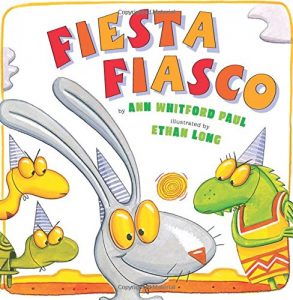 There is another desert party in the works in this spicy companion book to Mañana, Iguana. This time it is Snake’s birthday, and Iguana, Tortoise, and Rabbit are shopping for birthday gifts to bring to his fiesta. But what presents should they buy for Snake? In a sneaky twist, Rabbit convinces them to buy gifts that aren’t for Snake at all—but for him! With a clever text, a spattering of Spanish vocabulary. and lively illustrations, this author-illustrator team presents quite the fiesta fiasco. Glossary included.
There is another desert party in the works in this spicy companion book to Mañana, Iguana. This time it is Snake’s birthday, and Iguana, Tortoise, and Rabbit are shopping for birthday gifts to bring to his fiesta. But what presents should they buy for Snake? In a sneaky twist, Rabbit convinces them to buy gifts that aren’t for Snake at all—but for him! With a clever text, a spattering of Spanish vocabulary. and lively illustrations, this author-illustrator team presents quite the fiesta fiasco. Glossary included.
El Dilema De Trino
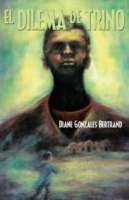
To be thirteen is worthless, Trino Olivares thinks. Trino has three little brothers he’s supposed to look after, but no father he can look up to. He rules at video games, but in the classroom, and out in the real world, he’s barely getting by—just like his mom, who scarcely manages to pay the bills and feed her kids by working all the time.Trino gets angry when he looks around at his terrible life. But when Rosca, an older teen with a vicious streak, invites him to start hanging with his crowd—and maybe make some quick money, too—Trino doesn’t know what to think. What kind of choices does he have, anyway? To run or die?
Ruiz Street Kids / Los Muchachos De La Calle Ruiz
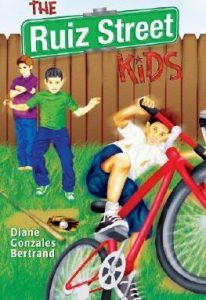 On a hot summer day, a new kid named David rides into the neighborhood. Gossip about the mysterious boy stretches longer than a wad of gum. The kids wonder why he rides a different bike everyday. Is he stealing them? He gets rough at the swimming pool, he scares the younger kids, and he spies over the fence. Why is he always so mean? Is it true that he eats a bee’s nest for breakfast and sleeps on a bed of nails? What does he want from the kids who live on Ruiz Street and why in the world would they ever want to be friends with somebody like David? The young narrator, Joe Silva, introduces intermediate readers to both his friends and their common enemy on Ruiz Street. David doesn’t have good people skills and doesn’t know quite how to improve them.
On a hot summer day, a new kid named David rides into the neighborhood. Gossip about the mysterious boy stretches longer than a wad of gum. The kids wonder why he rides a different bike everyday. Is he stealing them? He gets rough at the swimming pool, he scares the younger kids, and he spies over the fence. Why is he always so mean? Is it true that he eats a bee’s nest for breakfast and sleeps on a bed of nails? What does he want from the kids who live on Ruiz Street and why in the world would they ever want to be friends with somebody like David? The young narrator, Joe Silva, introduces intermediate readers to both his friends and their common enemy on Ruiz Street. David doesn’t have good people skills and doesn’t know quite how to improve them.
El Regalo Del Lenador / The Woodcutter’s Gift
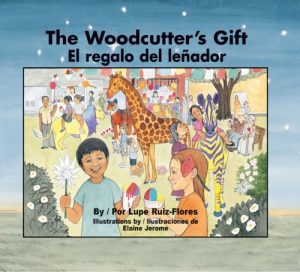 One day, a terrible thunderstorm knocked down the giant mesquite tree that grew in the town square. After the storm, the townspeople gathered to gawk at the large obstruction blocking the street. They weren’t sure what to do with it, but they all agreed that the wood was good for nothing except a fire. But the woodcutter Tomás sees something in the huge tree that the rest of the townsfolk don’t. “The beauty of this tree is not on the outside but on the inside,” Tomás tells them. In the following days, everyone watches curiously as the woodcutter carves and chips and whittles the wood into blocks. At one point, he moves the chunks into his shed, increasing everyone’s curiosity. What could the woodcutter be doing with all that lumber? Finally, Tomás calls the townsfolk together to see his creations: a wonderful collection of life-sized animals for the children to enjoy. Children and adults alike are thrilled with their private zoo! But a few weeks later the woodcutter is visited by strangers from a folk-art museum who want to buy the pieces for their collection. Will Tomás sell the town’s new zoo animals so that others can enjoy them too?
One day, a terrible thunderstorm knocked down the giant mesquite tree that grew in the town square. After the storm, the townspeople gathered to gawk at the large obstruction blocking the street. They weren’t sure what to do with it, but they all agreed that the wood was good for nothing except a fire. But the woodcutter Tomás sees something in the huge tree that the rest of the townsfolk don’t. “The beauty of this tree is not on the outside but on the inside,” Tomás tells them. In the following days, everyone watches curiously as the woodcutter carves and chips and whittles the wood into blocks. At one point, he moves the chunks into his shed, increasing everyone’s curiosity. What could the woodcutter be doing with all that lumber? Finally, Tomás calls the townsfolk together to see his creations: a wonderful collection of life-sized animals for the children to enjoy. Children and adults alike are thrilled with their private zoo! But a few weeks later the woodcutter is visited by strangers from a folk-art museum who want to buy the pieces for their collection. Will Tomás sell the town’s new zoo animals so that others can enjoy them too?
Illus: woodcuts
Carlos And The Cornfield / Carlos Y La Milpa De Maiz (Carlos Series)
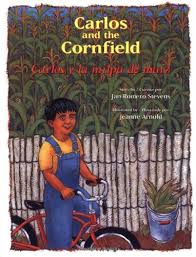
In this delightful sequel to “Carlos y la Planta de Calabaza”, Carlos is told by his father that “you reap what you sow”. After some humorous experiences, Carlos comes to understand the rewards of hard work and learns a valuable lesson in listening. Full color.
See the review at WOW Review, Volume 8, Issue 4
Carlos Y El Zorillo/ Carlos And The Skunk (Carlos Series)
Red Hot Salsa: Bilingual Poems On Being Young and Latino in the United States
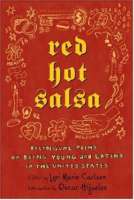
A collection of English and Spanish bilingual poems from the editor of Cool Salsa.
Little Crow to the Rescue/El Cuervito al Rescate
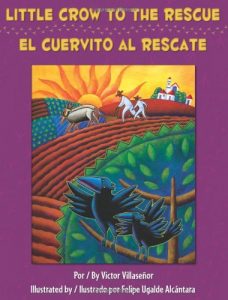 A colorful folktale about the natural world by a renowned Chicano writer Little Crow and Father Crow sit on the branch of a tall tree surveying the freshly planted corn field. Father Crow tells Little Crow that the human father and son they see working in the fields do a lot for crows. They plant corn, they move water, and they feed the crows with their fields. The crows sing their gratitude to the farmers, but in spite of their efforts to sing their best songs, the farmers don’t like the crows. As they watch, the tricky farmer bends to get a rock. He hides it by the side of his leg, and when they get in close range, the farmer launches his missile at the crows. But Little Crow and Father Crow are much too fast for him. They fly overhead, laughing and singing. Other crows are not so lucky, like Uncle Fly-Too-Late whose wing was broken when a farmer threw a rock. Little Crow is troubled. What if the farmer picked up a rock when Little Crow wasn’t looking? What if Little Crow couldn’t get away fast enough? Soon, Little Crow has an idea that just might save all the crows.
A colorful folktale about the natural world by a renowned Chicano writer Little Crow and Father Crow sit on the branch of a tall tree surveying the freshly planted corn field. Father Crow tells Little Crow that the human father and son they see working in the fields do a lot for crows. They plant corn, they move water, and they feed the crows with their fields. The crows sing their gratitude to the farmers, but in spite of their efforts to sing their best songs, the farmers don’t like the crows. As they watch, the tricky farmer bends to get a rock. He hides it by the side of his leg, and when they get in close range, the farmer launches his missile at the crows. But Little Crow and Father Crow are much too fast for him. They fly overhead, laughing and singing. Other crows are not so lucky, like Uncle Fly-Too-Late whose wing was broken when a farmer threw a rock. Little Crow is troubled. What if the farmer picked up a rock when Little Crow wasn’t looking? What if Little Crow couldn’t get away fast enough? Soon, Little Crow has an idea that just might save all the crows.
The Stranger And The Red Rooster/ El Forastero Y El Gallo Rojo
 One day in a small California barrio, a scary-looking stranger with an ugly scar on his face arrives. Silence falls on the streets. Normally raucous children stop playing, and their fearful mothers quickly beckon them inside. Everyone peeks out of windows and doors to watch the stranger walk down Main Street. Later in the week, the stranger again appears in town. And a few days later, on a pleasant Sunday morning, the man shows his frightening face yet again. But this time, he’s not alone. Cradled in the stranger’s arms is a big, red rooster with a yellow ribbon tied around its neck. When the rooster sets off after a bug with the stranger hanging on to the ribbon “like a cowboy who had lassoed a wild bull,” the townspeople are finally able to look past the long, ugly scar on the stranger’s face. Echoing the oral tradition common to so many Latinos, acclaimed author Victor Villaseñor shares with young readers one of his father’s favorite stories. With vibrant illustrations by José Jara, this will soon become the favorite of many children aged 3 to 7.
One day in a small California barrio, a scary-looking stranger with an ugly scar on his face arrives. Silence falls on the streets. Normally raucous children stop playing, and their fearful mothers quickly beckon them inside. Everyone peeks out of windows and doors to watch the stranger walk down Main Street. Later in the week, the stranger again appears in town. And a few days later, on a pleasant Sunday morning, the man shows his frightening face yet again. But this time, he’s not alone. Cradled in the stranger’s arms is a big, red rooster with a yellow ribbon tied around its neck. When the rooster sets off after a bug with the stranger hanging on to the ribbon “like a cowboy who had lassoed a wild bull,” the townspeople are finally able to look past the long, ugly scar on the stranger’s face. Echoing the oral tradition common to so many Latinos, acclaimed author Victor Villaseñor shares with young readers one of his father’s favorite stories. With vibrant illustrations by José Jara, this will soon become the favorite of many children aged 3 to 7.

